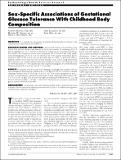| dc.contributor.author | Regnault, Nolwenn | en_US |
| dc.contributor.author | Gillman, Matthew W. | en_US |
| dc.contributor.author | Rifas-Shiman, Sheryl L. | en_US |
| dc.contributor.author | Eggleston, Emma | en_US |
| dc.contributor.author | Oken, Emily | en_US |
| dc.date.accessioned | 2014-11-03T17:38:32Z | |
| dc.date.issued | 2013 | en_US |
| dc.identifier.citation | Regnault, Nolwenn, Matthew W. Gillman, Sheryl L. Rifas-Shiman, Emma Eggleston, and Emily Oken. 2013. “Sex-Specific Associations of Gestational Glucose Tolerance With Childhood Body Composition.” Diabetes Care 36 (10): 3045-3053. doi:10.2337/dc13-0333. http://dx.doi.org/10.2337/dc13-0333. | en |
| dc.identifier.issn | 0149-5992 | en |
| dc.identifier.uri | http://nrs.harvard.edu/urn-3:HUL.InstRepos:13347433 | |
| dc.description.abstract | OBJECTIVE To examine the associations of maternal gestational glucose tolerance with offspring body composition in late childhood. RESEARCH DESIGN AND METHODS Among 958 women in the prebirth cohort Project Viva, glucose tolerance was assessed in the second trimester by nonfasting 50-g 1-h glucose challenge test (GCT), followed if abnormal by fasting 100-g 3-h oral glucose tolerance test (OGTT). We categorized women as normoglycemic (83.3%) if GCT was ≤140 mg/dL, isolated hyperglycemia (9.1%) if GCT was abnormal but OGTT normal, intermediate glucose intolerance (IGI) (3.3%) if there was one abnormal value on OGTT, or gestational diabetes mellitus (GDM) (4.5%) if there were two or more abnormal OGTT values. Using multivariable linear regression, we examined adjusted associations of glucose tolerance with offspring overall (N = 958) and central (N = 760) adiposity and body composition using dual X-ray absorptiometry (DXA) measured at the school-age visit (95 ± 10 months). RESULTS Compared with that in the male offspring of normoglycemic mothers, DXA fat mass was higher in male offspring of GDM mothers (1.89 kg [95% CI 0.33–3.45]) but not in male offspring of mothers with IGI (0.06 kg [−1.45 to 1.57]). DXA trunk-to-peripheral fat mass, a measure of central adiposity, was also somewhat higher in male offspring of GDM mothers (0.04 [−0.01 to 0.09]). In girls, DXA fat mass was higher in offspring of mothers with IGI (2.23 kg [0.12–4.34]) but not GDM (−1.25 kg [−3.13 to 0.63]). We showed no association of gestational glucose tolerance with DXA lean mass. CONCLUSIONS In this study, only male offspring of GDM mothers manifested increased adiposity, whereas only female offspring of mothers with IGI did so. Sex differences in glycemic sensitivity may explain these findings. | en |
| dc.language.iso | en_US | en |
| dc.publisher | American Diabetes Association | en |
| dc.relation.isversionof | doi:10.2337/dc13-0333 | en |
| dc.relation.hasversion | http://www.ncbi.nlm.nih.gov/pmc/articles/PMC3781569/pdf/ | en |
| dash.license | LAA | en_US |
| dc.subject | Epidemiology/Health Services Research | en |
| dc.title | Sex-Specific Associations of Gestational Glucose Tolerance With Childhood Body Composition | en |
| dc.type | Journal Article | en_US |
| dc.description.version | Version of Record | en |
| dc.relation.journal | Diabetes Care | en |
| dash.depositing.author | Gillman, Matthew W. | en_US |
| dc.date.available | 2014-11-03T17:38:32Z | |
| dc.identifier.doi | 10.2337/dc13-0333 | * |
| dash.contributor.affiliated | Rifas-Shiman, Sheryl | |
| dash.contributor.affiliated | Oken, Emily | |
| dash.contributor.affiliated | Gillman, Matthew | |
| dc.identifier.orcid | 0000-0003-2513-3339 | |


